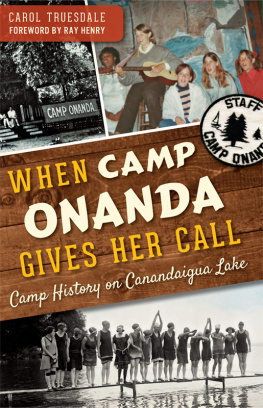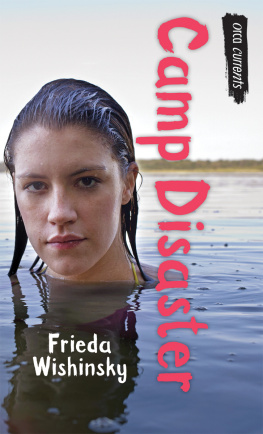

Published by The History Press
Charleston, SC 29403
www.historypress.net
Copyright 2015 by Carol Truesdale
All rights reserved
First published 2015
e-book edition 2015
ISBN 978.1.62584.775.1
Library of Congress Control Number: 2015934856
print edition ISBN 978.1.62619.289.8
Notice: The information in this book is true and complete to the best of our knowledge. It is offered without guarantee on the part of the author or The History Press. The author and The History Press disclaim all liability in connection with the use of this book.
All rights reserved. No part of this book may be reproduced or transmitted in any form whatsoever without prior written permission from the publisher except in the case of brief quotations embodied in critical articles and reviews.
Contents
Foreword
In 1907, the village of Canandaiguas board of trade (predecessor of the Canandaigua Chamber of Commerce) penned a booklet titled Canandaigua, Its Advantages, Growth and Beauty to call attention to many of Canandaiguas leading features. In that effort, in its introduction, it stated, In recent years the Village has become more than ever popular as a summer resort, and along the tree embowered and vine clad shores of the loveliest of Western New York lakes has grown up a summer colony which finds in the bracing air, the limpid beauty of the waters and the rugged glory of the hills, a welcome relief from the stifling bounds of encircling walls and glaring pavements.
Through the first few decades of the 1900s, before paved roads and SUVs, before electric lines and Ma Bell, before $3,000-per-foot shoreline prices and before modern affluence, life on Canandaigua Lake was laid-back and simple. Groceries were delivered by boat, as was the mail, especially toward the steeply hilled south end. The steamboats made regular stops at many of the points. Names like Hope Point, Tichenor Point, Menteth Point, Fosters Point, Point Rochester, Seneca Point, Granger Point, Woodville, Cooks Point and Black Point were regular stops for the big, smoke belching steamers. Red Dock, Bay View, Laphams Point, Davidsons Landing and Main Top also had wooden docks with flagpoles used to signal the need for a steamer. Most sites were either hotels or family cottages without electricity. As with all the Finger Lakes, the roads that accommodated horses and buggies and early autos, such as West Lake Road, were dirt or gravel. Canandaiguas highway superintendant Ira Cribb was the first in Upstate New York to develop and successfully implement the oil and stone application on rural roads. At that point in time, West Lake Road was narrow and twisting and not conducive to any speed. To the residents, it was a dead-end road. Ontario County maps as late as 1920 show West Lake Road as an improved highway only from the city limits to Tichenor Point.
Childrens laughter echoed from the swing sets and beach picnic tables at the district school on the corner of Butler Road. A great deal of activity could be seen at the riding academy at the Denton farm. Many children and young adults enjoyed hikes and sports at the numerous camps along the west side of the lake, including the natural science camp at Tichenor Point.
The booklet also declared:
It is difficult to describe the beauties of the lake itself and of the surrounding country without running the risk of inducing incredulity in the average reader, but the fact remains that many who have had opportunity to view the famous resorts of this and other countries concur in saying that for attractive features Canandaigua Lake is surpassed by few small bodies of water either in this country or abroadAs the traveler proceeds up the lake his eye is regaled with an ever changing vista, showing gradually less and less of the characteristics of the agricultural landscape and merging into a delightful confusion of lofty hillsides covered with the primeval growth and as yet practically unscarred by the implements of industryThere are a number of good resorts along the lake where pleasant rooms and good board may be obtained at a reasonable rate and attractive cottages may also be rented during the summer.
Canandaigua Lake had long been a summer mecca for many families, dating back to the mid-1800s. In fact, most residents in those times and up to World War II were primarily summer residents, starting as soon as school was out in late June and then packing up and heading home on Labor Day weekend. They came by steamboat, horse and buggy and auto (to the extent that they could navigate the narrow, steep one-lane roadways).
Enter Camp Onanda on the scene. Onanda is an Indian word meaning tall fir or pine, a symbol of strength and simplicity. In 1911, William Foster, an early owner of this site, passed away. Later in that year, the Young Womens Christian Association (YWCA) of Rochester, Monroe County, New York, began renting the home and grounds as a place where working adult women could rest and enjoy recreational activities. In 1919, the YWCA purchased the property known as Shale Rock from the W.L. Foster Estate. Over the next several years, many of the buildings that exist there today where constructed, and by the mid-1920s, the YWCA had begun using the camp for junior campers as well as adult women.
The park has a rich history, including its original purpose as the YWCA Leisure Time School (starting in the early twentieth century) and at one time, the site of Camp Good Days and Special Times. A cooperative purchasing effort in 1989 by the Town of Canandaigua; the New York State Department of Parks, Recreation and Historic Preservation; and the Department of Environmental Conservation was successful in an effort to improve recreational opportunities and access for the public. It was opened as such in 1990. Fishing, swimming, family picnics and gatherings have proven popular at this year-round recreation area.
Located on West Lake Road (County Road 16), todays Onanda is an exceptional and unique property about eight miles south of the city of Canandaiguatruly a gem in the middle of the Finger Lakes. Today, it encompasses eighty acres, seven of which are lakeside and house eight cabins, two pavilions and two lodges, and all of which are available to the public. The seventy-three acres of hillside running along Barnes Road contain a two-mile hiking path, three pavilions, seven cabins, winter sledding and overflow parking.
As a lifelong resident of the Canandaigua area and present town of Canandaigua historian, I have hoped, for many years, to have a history of this vital town asset penned by someone who has had an intimate relationship with the camp and shares the desire to bring its history to public awareness. Carol Truesdale, a past counselor at the camp, has used her life experience and time with the YWCA to weave this biological sketch of Onanda.
I have known Carol for several years, and we have shared a love of Canandaigua Lake history. Besides her years with the camp, Carol and her family spent many years summering on the east side of Canandaigua Lake at the cottage they built at the foot of Genundewah (Bare Hill). And she admits, If I was to seriously consider the experiences that have truly impacted my life, at the very top of such a list would be Canandaigua Lake, followed by travel and teaching.
A 1972 graduate of the State University of New YorkGeneseo, Carol taught English, history and reading to classes ranging from first to sixth grade in the Churchville-Chili Central School District of Monroe County, New York, over a twenty-five-year career. She uses her well-honed educational talents to craft an interesting story of the Camp Onanda years.
Next page














